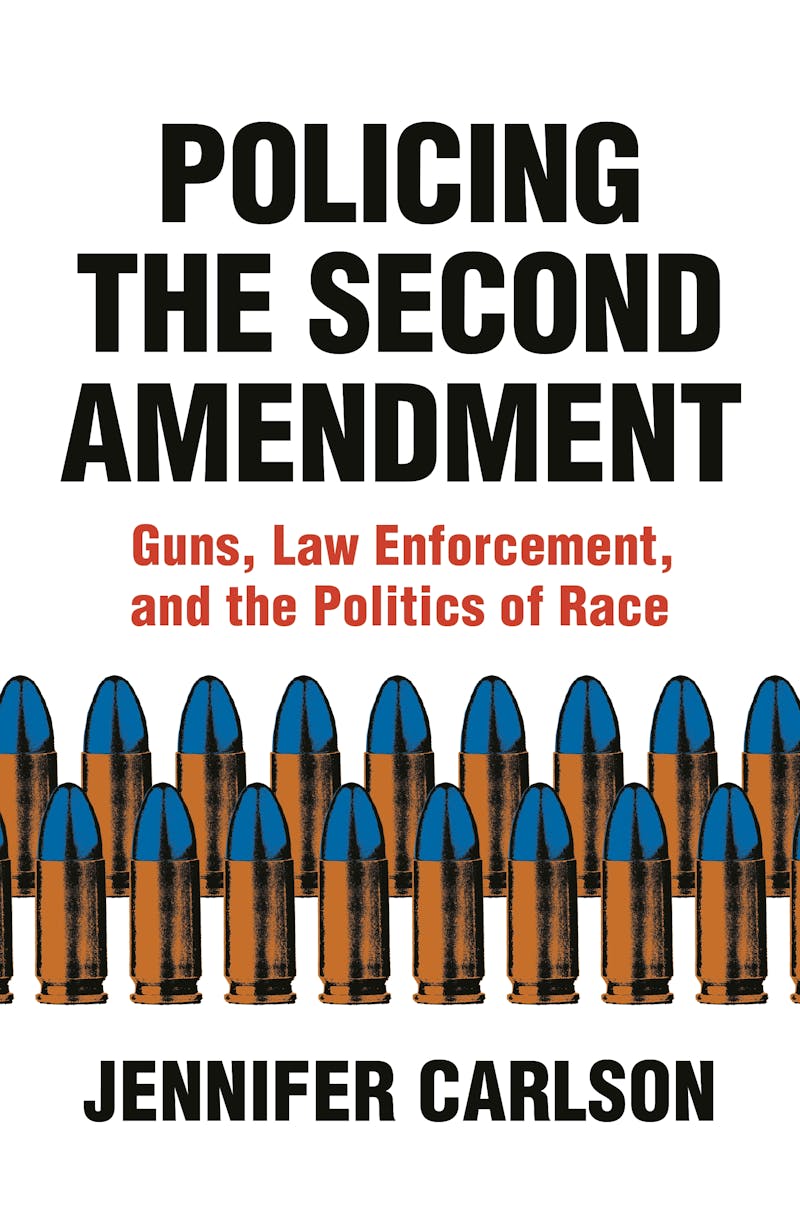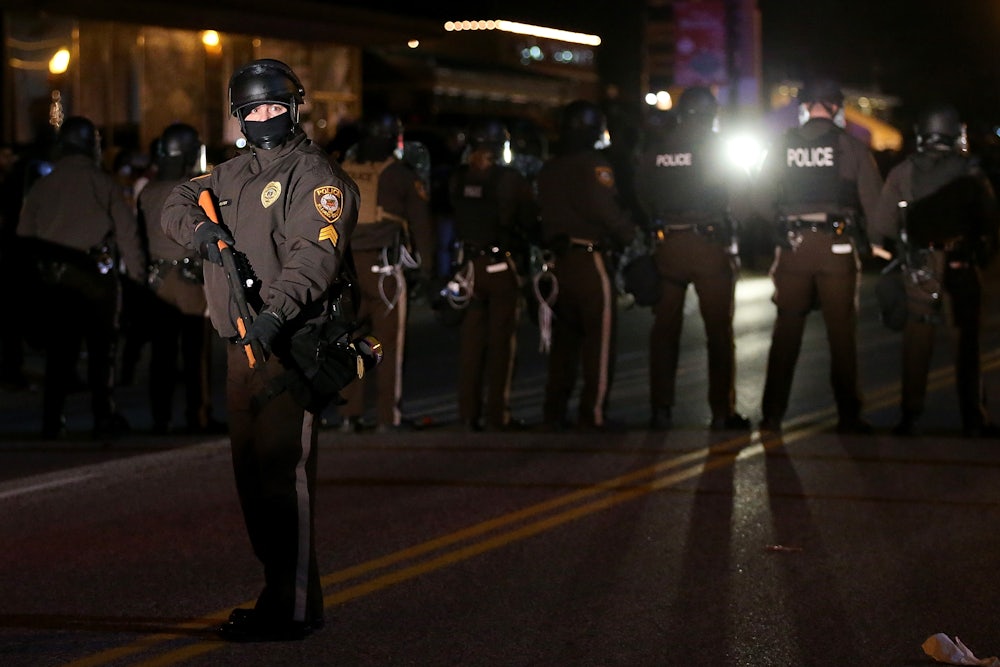Three years since Charlottesville, armed clashes at street protests over racial justice are still a defining feature of American politics, but the constellation of participants has changed. The white supremacists who paraded in fascist sword-and-sandals kitsch with homemade shields and spears have sharply receded. But the paramilitaries who showed up that August claiming to be neutral security are now represented in greater numbers. Nazis are out, patriots are in. And while cops sat on the sidelines in Charlottesville, they have welcomed “good guys with guns” to buttress “law and order” as they brutally suppress this year’s eruption of social justice protest, even though time and time again, the militias and armed citizens have provoked rather than deterred violence.

A new book from University of Arizona sociologist Jennifer Carlson goes a long way to explaining why. Drawing on interviews with 80 police chiefs, Policing the Second Amendment illuminates how central guns are to the ideology of police. Firearms carriers, including police, Carlson argues, believe that guns don’t merely offer personal protection: The weapons produce a larger social order, enforcing the boundary between “good guys” and “bad guys.” Thus carrying a gun is a higher form of citizenship: a commitment to wield deadly force to protect fellow Americans, which Carlson likens to “hardened care work.” For the subjects of her book, guns make the guy good, in a refraction of the old National Rifle Association adage that “guns don’t kill, people do.” It’s “bad guys” who commit criminal acts of violence, and only with guns can good people stop them. The implication, of course, is that gun carriers are constantly preoccupied with fear of lethal threat from a social other.
Rarely do the police chiefs or concealed carriers whom Carlson interviews stop to consider if the ubiquity of firearms in America is the source of that constant sense of danger. Instead, their worldview is guided by twin instincts: what Carlson calls “gun militarism” and “gun populism.” Gun militarism, espoused by essentially every chief she interviewed, is synonymous with the infamous “Warrior Cop” training that conditions police to think of the world as filled with enemies at every corner who must be overpowered at all costs, necessitating an arms race with criminals. Gun populism, meanwhile, aligns with the pro-gun dogma that lawful gun owners carrying in public make America safer either by providing quick responses to threats when police aren’t present or by deterring crime in the first place. One is a top-down approach to meeting an ever-present threat, the other bottom-up. Most of the chiefs Carlson interviewed argued that gun militarism and populism complement one another.
That’s by the NRA’s design. As Carlson traces the professionalization of policing alongside the story of America’s civilian handgun culture, she shows how crucial the gun lobbying group has been to both developments. The NRA cultivated two constituencies, cops and “lawful” civilian gun owners, around a shared goal: protecting the prerogative to wield deadly force to preserve a racialized social hierarchy. The project has been so successful that both cops and their civilian counterparts have begun to treat guns as far more than mere tools—rather, as guarantors of their own honored place in society, like a feudal knight’s sword. It’s no surprise, then, that both cops and civilian gun owners have cathected so much meaning onto their firearms. And it also means the right to armed self-protection—supposedly universal according to the Supreme Court’s ruling in the 2008 Heller case—has always been strictly limited in practice, as lawful but nonwhite firearm carriers like Philando Castile have found out to deadly effect.
Before the late nineteenth and early twentieth century, policing was often informal, privatized, and regionally varied. It was not directed at “fighting crime” so much as compelling the obedience of slaves in the South, industrial labor in the North, and Native Americans in the West. Likewise, for all the mythology of the six-shooter, civilian gun owners prior to the twentieth century usually kept a rifle, which was not suitable for urban home- or self-defense. Around the turn of the century, however, all that changed.
It was only as America rapidly urbanized and developed a proletariat of immigrants from Southern and Eastern Europe and Black migrants from the South that “crime” became an issue of central public concern. Rhetoric about crime, though ostensibly color-blind, was inherently racialized, because vice and associated violence were shunted into immigrant and Black neighborhoods. “Crime” in these neighborhoods and among these populations thus became naturalized.
In their efforts to cordon these growing marginalized communities off from the “law-abiding” white majority, police professionalized and standardized their practices across the country. The NRA made sure that process included comprehensive handgun training. In 1916, one NRA official wrote in the organization’s in-house magazine, “When the time comes and every policeman is capable of drawing his revolver or pistol with the least possible delay and shooting it accurately, the lawbreakers, who now hold little fear of the policeman’s aim, will think twice before drawing their fire,” laying out the Warrior Cop ideology avant la lettre. The group began to train officers in handgun use. According to another scholar Carlson quotes, “the significance of this development cannot be overstated, for it propelled the NRA into the role of national sanctioning body for police firearms training.”
Likewise, American handgun culture only developed in the early twentieth century, when demobilization from World War I created a global glut of firearms that militaries no longer needed. The surge of guns in civilian hands naturally led to America’s first wave of criminal gun violence during the Prohibition years and thus the first calls for gun control. Notably, the NRA successfully kept handguns unregulated in the first major federal gun control bill, passed in 1934. It successfully fought a renewed push to ban or restrict handguns in the 1960s and 1970s. The NRA has so thoroughly insinuated self-defensive gun carrying into American life that even as the gun control movement reached a zenith, in the wake of the 2018 Parkland shooting, it essentially abandoned its historical goal of restricting handguns.
After decades of NRA lobbying, gun laws are as likely to encourage gun carrying as to restrict it. A growing number of states, like Arizona, have so enthusiastically embraced gun populism that they no longer regulate guns in public at all. In places that do license firearms, police decide who gets to pack. Carlson observed the sheriff-run process in Michigan, one of the few states with public licensing hearings, and found that it often brutally reproduced racial hierarchy. Not only were African American applicants for concealed carry permits more likely than white applicants to be denied because of a criminal record, they were also subjected to more scrutiny in cases where the sheriffs had discretion and to revocations for nonviolent offenses; lectures on respectability politics; and, in a surprising number of cases, threat of arrests for open warrants.
This has been the NRA’s two-pronged strategy to the problem of gun violence since the early twentieth century: Convince both police and civilians to arm themselves heavily and to kill without a second thought as part of a never-ending “war on crime,” fought against internal opponents who pose a threat because of their innate “bad guy”-ness. The persistence of gun violence is just more evidence that the war has not been waged ruthlessly enough, that the Other side has not been sufficiently overpowered. As a result of a century of political organizing and lobbying, civilian gun owners and police see themselves as co-combatants fighting a perpetual domestic counterinsurgency. In other words, gun owners are cops, and cops are troops.
Though Carlson’s frame is strictly domestic, it is naturally in dialogue with work by security scholar Stuart Schrader on the ways that Cold War tactics developed by the United States and its allies to fight a global Communist and anti-colonial insurgency came back home to American policing, as well as historian Kathleen Belew’s work on the ways that America’s involvement in anti-Communist proxy wars shaped the latter-day militant hard-right movement. Read together, this body of work demonstrates a shared structure of feeling among concealed carriers, outright vigilantes, militia members, cops, and the American crusaders who fought the Cold War and later the “war on terror”: the conviction that the American way of life only survives because hard men are willing to kill to protect it. To these men, attempts to restrict their use of force amount to a threat to that way of life.
It’s not surprising, then, that police have readily joined forces with the armed far right to suppress the Black Lives Matter movement, which has been sparked by both police shootings like the one that took the life of Breonna Taylor and civilian gun vigilantism exemplified by the killing of Trayvon Martin.
BLM seeks to overturn a racialized social order that is reproduced by guns. What will the police and civilian gun carriers who uphold that order do if the movement succeeds? Carlson’s research was conducted before most Americans even thought about the possibility of defunding, disarming, or abolishing police. Her interview subjects do not consider whether social arrangements that have persisted for a century might soon change. In defeat and resentment, their sense of mutual allegiance may only intensify. As Carlson demonstrates, police are deeply invested in their identity as armed enforcers of social hierarchy and see “good guys with guns” as natural allies. As the NYPD has repeatedly demonstrated, cops are perfectly willing to flout orders from democratically elected liberal politicians who call for de-escalating violence. Likewise, in California, gun owners disregard frequent new gun restrictions with little consequence. From the vigilantes of the post–Civil War South to post-Ba’athist Iraq, history is littered with examples of what happens when disgruntled armed men feel they’ve been stabbed in the back: They rarely just give up their guns.
Those who seek to defund the police and their counterparts in the movement to reduce the ubiquity of guns in everyday life face the challenges not just of adjusting budget line items, changing a policy here or there, or regulating a consumer good: They’ll have to de-escalate a social conflict that has ordered American political and social life for a century. It’s a daunting task but worth pursuing. The payoff will liberate not just the people behind those movements but also the men who live in constant fear of relaxing their trigger finger.
